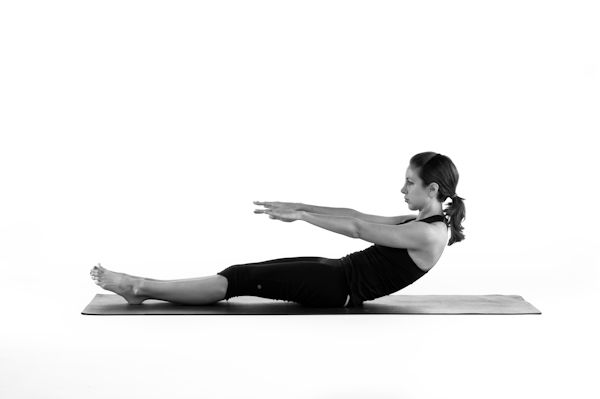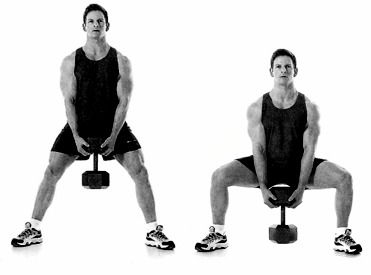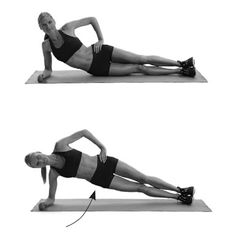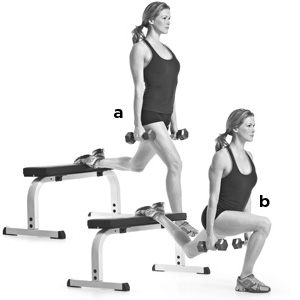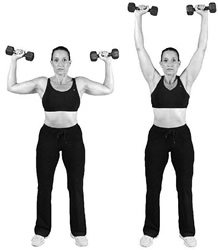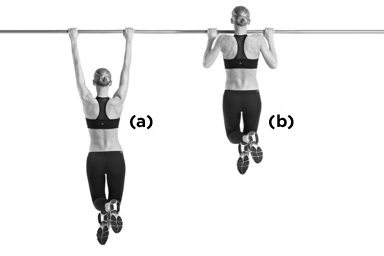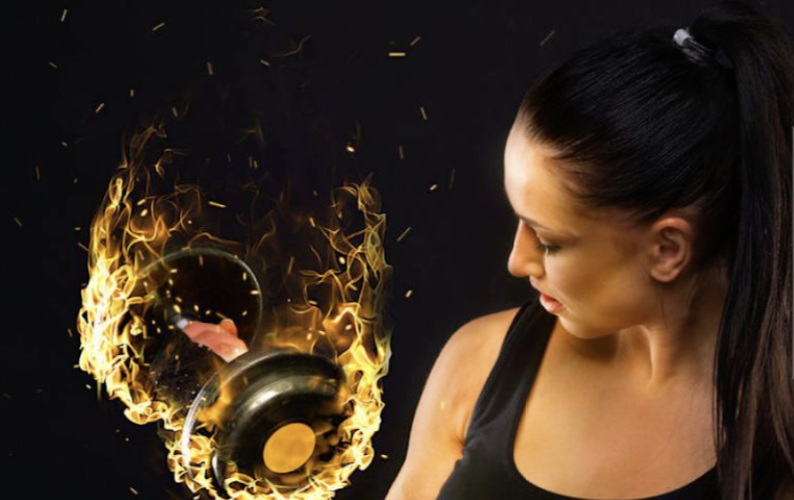
Heading into the gym with a solid workout plan is a surefire way to have a successful, efficient sweat session. But figuring out exactly what strength exercises to do can get a little tricky. While certain exercises (think biceps curls and crunches) seem like easy, familiar choices, they’re not always the best bet for seeing results. In fact, just because everyone’s doing a certain move, doesn’t mean it’s even safe.
“It’s important to measure the risk-to-benefit ratio of any exercise,” says Susie Crossland-Dwyer, strength and run coach and founder of Studio S in Cincinnati, OH. She tends to avoid exercises that target a single muscle or muscle group and moves that carry little benefit with high risk of injury. So what are the strength exercises trainers never do? Here are eight for starters, plus recommendations for safer, more effective substitutions.
Strength Exercises You Should Skip and What To Do Instead
1. Skip: Crunches
Old news that still rings true: Crunches aren’t nearly as effective as other core exercises. Yet people still continue to do them. “A lot of exercise enthusiasts do crunches ad nauseam without really increasing their core strength,” says Crossland-Dwyer. What’s worse is the move can lead to neck or back pain and sometimes hip issues.
Substitution: Pilates Roll-Up
Unlike a traditional crunch, this move targets deeper layers of your abs, which will increase your stability and improve your posture.
How to: Lie on your back with your legs extended and your arms overhead, palms facing one another (a). Slowly roll up, making a C-shape with your spine as you do. Your abs should be pulled in and engaged during the entire movement, creating a hollowing feeling through the low abdominals (b). Continue to roll forward into a stretch, while keeping your shoulders down, away from your ears (c). Hold the stretch for about 10 seconds, then roll back to start and repeat.
2. Skip: Hip Abductor Machine
“People often think that machines make it easier to perform the exercise movement and manipulate the body because they look user-friendly,” says Nikki Snow, a Les Mills International trainer based in Chicago. But strength exercises on hip abductor machines often aren’t as beneficial as moves with free weights or even just your bodyweight. “The abductor machine — aka thigh master machine — packs a big burn, but there are more effective exercises that can isolate the side glutes and hips safe and effectively.”
Substitution: Sumo Squat
This squat variation, with your legs wide apart, targets your inner thighs like none other.
How to: Stand with legs a few steps wider than hip-width apart, toes turned out. Hold a dumbbell in each hand at your hips (a). Lower your hips down and back until your thighs are parallel to the floor (b). Stand back up and repeat.
3. Skip: Weighted Standing Side Bends
Holding a dumbbell on one side of your body during side bends “puts the spine in a compromised position, and it’s hard to maintain alignment to isolate the obliques properly,” says Snow. “It’s easy to use momentum and rock side to side, which can put strain on the lower back and decrease isolation in the targeted muscle group.”
Substitution: Side Plank with Hip Lift
“This move isolates the obliques and strengthens shoulders and surrounding core muscles very effectively,” Snow says.
How to: Lie on your side and prop yourself up on your forearm and elbow. Your feet, hips and shoulders should align. Extend your top arm toward the ceiling (a). Lift your hips off the ground and up toward the ceiling. Hips should stay stacked, with body in one straight line (b). Lower your hips a few inches toward the floor, then lift back up to a straight side plank, using your abs to move you (c). Repeat.
4. Skip: Leg Press
The leg press can be fun, because you can typically lift more weight on the machine than you can handle on a standing squat, so you feel extra-powerful. But that increased weight is part of the problem, says Greg Justice, MA, owner of AYC Health and Fitness in Kansas City, KS. “The biggest problem I see with the leg press is the inclination to put too much weight on the machine, potentially causing the pelvis to rotate away from the back rest as you lower the weight. This can cause a herniated disc.” Plus, using the leg press takes stability out of the equation, forcing your quads to do most of the work, without hitting the hamstrings or glutes, says Crossland-Dwyer.
Substitution: Bulgarian Split Squat
“With split squats, you start with stabilizing the body before going through the range of motion,” Justice explains. “You need to engage the whole body throughout the entire process, and that transfers to real life movements or recreational sports.”
How to: Stand with your back facing a bench or box. Put one foot on top of the bench. Make sure you’re far enough away from the bench so you can create a 90-degree bend in your front knee (a). Bend your front knee to lower your back knee toward the ground, and aim to get your front thigh parallel to the floor (b). Push through the heel of your front foot to return to the starting position, keeping your chest up, eyes forward and shoulders back (c). Repeat.
5. Skip: Russian Twist
This core workout move, in which you sit on the floor and twist from side to side (usually holding a weight), is a popular one. While it might seem more functional than a crunch, it’s not necessarily better. “Recent research has shown that Russian twists are more harmful than beneficial,” says James Thomas, a Les Mills national trainer based in New York City. “Combining the compression and flexion of this movement with rotation places a lot of pressure on the spinal disc, excessive compression of the lumbar spine, and movement of disc fluid.”
Substitution: Forearm Plank with Hip Dips
Planks target your entire core while keeping the spine in a safe, neutral position. Add a side-to-side motion and you also get deep into the side of your abs, aka your oblique muscles.
How to: Bring your elbows directly under your shoulders pressing both forearms into the floor. Keeping feet hip-distance apart, extend legs behind you as you bring your body off the ground. Your body should from a straight line from head to heel as you keep your chin tucked in, squeeze your abs tight, and tailbone tucked (a). When you’re steady, slowly drop your left hip toward the floor (b). Bring your hips back toward neutral, and continue through the middle to drop your right hip toward the floor (c). Continue alternating.
6. Skip: Behind-the-Head Military Press
This move is a common one with body builders, but it’s far from the safest way to gain muscle in your upper body. “It puts undue stress on most people’s shoulders — even if you were just doing the movement with a broomstick,” says Mike Donavanik, CSCS, a personal trainer based in Los Angeles. “Most people lack the shoulder mobility, strength, posture and stabilization to do this correctly.” As a result, the movement pattern gets messed up, other muscles start compensating, and you could walk away with an upper body injury.
Substitution: Arnold Press
You’ll work through a full range of motion with this exercise, nixing excess stress on your shoulder joints. Plus, it uses dumbbells rather than a barbell, so each arm and shoulder joint has to work independently of the other, says Donavanik. “If you have any mobility or strength issues on one side, you’ll figure it out pretty quickly this way.”
How to: Start standing with one dumbbell in each hand, elbows bent and palms facing you with dumbbells held at just above collarbone level (don’t let the weights rest on your body) (a). Open your arms out to the sides, bringing your palms to face forward (c). Then, press the dumbbells up overhead. Palms should face away from you by the time you reach the top of the motion (d). Lower back down the way you went up and repeat.
7. Skip: Kipping Pull-Up
These swinging pull-ups — the ones you see CrossFitters busting out like nobody’s business — do look cool. And the momentum you generate while moving your body forward and back allows you to do more reps than traditional pull-ups. But there’s a catch. You’re putting your shoulders at risk if they aren’t strong enough to support the swinging force. “Most people just don’t have the muscular strength and shoulder mobility to do these safely,” says Justice.
Substitution: Traditional Pull-Up
A regular pull-up is one of the best moves you can do for your upper body. It’s a true compound exercise, working muscles in your back, shoulders, and arms at once, says Justice.
How to: Grab onto a bar with an overhand grip (palms facing away from you), hands shoulder width apart (a). Starting with your arms straightened, pull yourself upward until chin is over the bar. Don’t arch your back or swing; instead bend your knees and cross your feet (b). Then lower to start and repeat. (Can’t do a pull-up without swinging? Check out these exercises to get you there, then check out this how-to for working up to full range of motion.)
This article was originally published here

